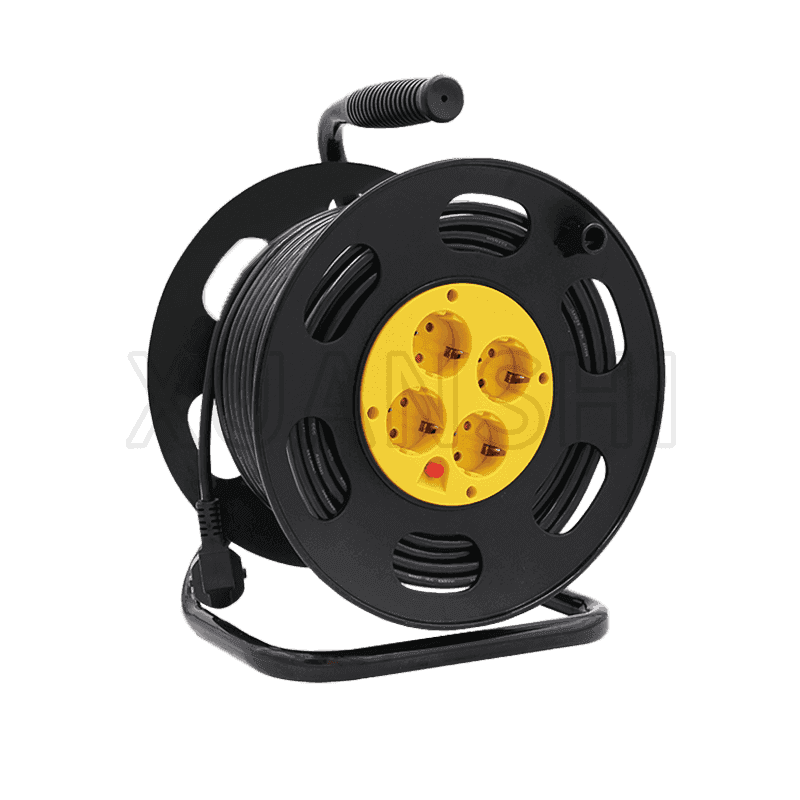The locking mechanism of an extension cable reel is crucial for preventing the cable from unwinding accidentally. Typically, extension cable reels employ a variety of locking mechanisms to ensure the cable stays securely wound when not in use. These mechanisms may include:
Ratchet Locking System: The ratchet locking system is a sophisticated mechanism that operates within extension cable reels to provide users with precise control over cable extension. It consists of a series of toothed gears or a pawl-and-ratchet mechanism integrated into the reel's design. When the cable is pulled out, the pawl engages with the teeth on the drum, creating a locking action at regular intervals. This engagement produces audible clicks, indicating that the cable has reached a secure, locked position. The spacing between the teeth determines the length increments at which the cable can be extended and locked. To retract the cable, users activate a release lever or button, which disengages the pawl from the teeth, allowing for smooth winding.
Automatic Locking Mechanism: Extension cable reels featuring automatic locking mechanisms utilize advanced tension-sensing technology to provide seamless cable management. Typically, these mechanisms incorporate a spring-loaded or centrifugal mechanism that detects the tension exerted on the cable as it is pulled out. Once the cable reaches a predetermined tension threshold, the locking mechanism automatically engages, securing the cable at the desired length. This automatic engagement eliminates the need for manual intervention and ensures that the cable remains securely extended during use. To retract the cable, users activate a release mechanism, such as a button or lever, which disengages the locking mechanism and allows for effortless retraction.
Manual Locking Button or Switch: The manual locking button or switch is a user-controlled locking mechanism that offers precise control over cable extension. It typically consists of a mechanical latch or cam mechanism integrated into the reel's design. When the cable is extended to the desired length, users press a button or flip a switch to engage the locking mechanism, securing the cable in place. This manual locking action provides users with flexibility and customization options, allowing them to adjust the extension length to suit their specific needs. To retract the cable, users release the lock by pressing the button or flipping the switch again, enabling smooth and controlled winding.
Spring-Loaded Locking Pin: Extension cable reels equipped with spring-loaded locking pin mechanisms utilize a spring-loaded pin that interfaces with notches or grooves on the reel's drum. As the cable is extended, the spring-loaded pin automatically engages with the nearest notch, effectively locking the cable in place. This mechanism ensures a secure hold and prevents accidental unwinding during use. The tension of the spring determines the force required to disengage the locking pin. To retract the cable, users pull it with sufficient force to overcome the spring tension, disengaging the locking pin and allowing for effortless retraction.
Twist-Lock Mechanism: The twist-lock mechanism offers a user-friendly locking solution that operates via a simple twisting motion. It typically consists of a threaded shaft or cam mechanism integrated into the reel's design. When the cable is extended to the desired length, users twist a knob or handle to engage the locking mechanism, preventing further extension. This twisting action creates a mechanical lock that securely holds the cable in place. The thread pitch or cam profile determines the amount of force required to engage and disengage the lock. To retract the cable, users twist the knob or handle in the opposite direction, releasing the lock and allowing for smooth winding.
4x16A sockets germany type extension cable reel JL-3,XS-XPD1
